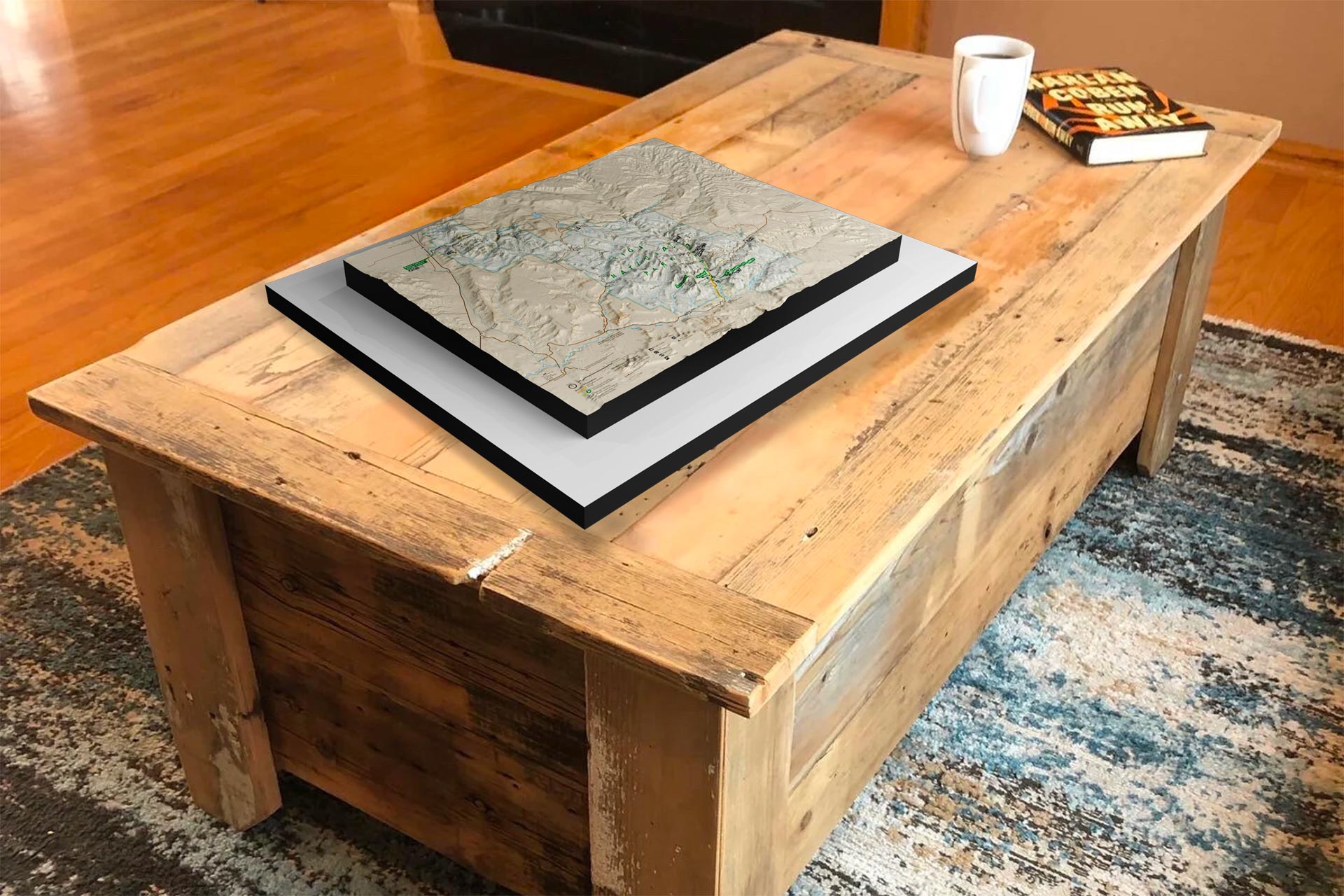Zions National Park 3D Maps
We Build Custom 2D and 3D National Park Maps
Did you know we make
custom
3D raised-relief maps
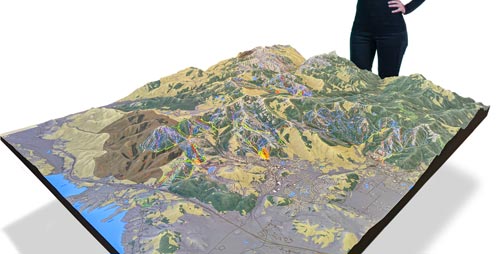
and
3D national park maps
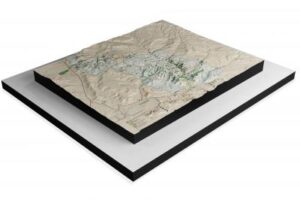
Exploring Zion National Park with 3D Maps
Nestled in the heart of southwestern Utah, Zion National Park stands as a testament to nature’s unparalleled beauty and the ceaseless artistry of geological forces. Spanning over 146,000 acres, this natural wonderland has been drawing adventurers and nature enthusiasts for generations. In recent years, the park’s allure has been further magnified with the advent of 3D mapping technology, allowing visitors to immerse themselves in a more immersive and exciting experience than ever before.
The Geological Epic of Zion National Park
In order to fully appreciate the transformative potential of 3D maps within Zion National Park, it’s crucial to dive into the awe-inspiring geological history that has shaped this natural masterpiece. This rugged terrain, sculpted over countless eons by the ceaseless dance of the Virgin River, stands as a living confirmation to the profound forces of erosion and geological metamorphosis.
Millions of Years in the Making
The story of Zion’s formation begins millions of years ago when the area was submerged beneath a vast inland sea. Over time, sediment deposits accumulated, and the Earth’s crust heaved and folded, thrusting these ancient seabeds skyward. Erosion, acting as nature’s chisel, gradually began to carve out the intricate forms that we marvel at today.
Towering Sandstone Monoliths
Among the most striking features of Zion National Park are its towering sandstone cliffs, their russet hues glowing brilliantly in the desert sun. These colossal formations, like the famous Court of the Patriarchs and the Great White Throne, are composed of Navajo Sandstone, a geological wonder that tells tales of ancient desert dunes preserved in stone.
Narrow Slot Canyons and Hidden Wonders
Narrow slot canyons, such as The Narrows and Zion’s Subway, add an element of enchantment to the park’s geological diversity. These sinuous passageways, etched by water over millennia, offer glimpses into the subterranean world and showcase the artistry of water and time. 3D maps can unravel these labyrinthine passages and allow you to appreciate their intricate beauty.
Zions National Park NPS 3D Map by WhiteClouds
Lush Oases and Ecological Riches
While the park’s rugged facade is its defining feature, hidden oases like the Emerald Pools and the verdant Zion Canyon provide a stark contrast to the harsh desert environment. The Virgin River, the lifeblood of the park, nourishes these lush pockets of greenery, serving as a sanctuary for a diverse range of plant and animal species. 3D mapping technology can help you explore these hidden ecosystems and their intricate relationships with the surrounding desert landscape.
Elevations and Ecological Zones
Zion National Park’s elevations span from 3,700 to 8,726 feet above sea level, creating a mosaic of distinct ecological zones. From the lower desert floors to the alpine heights of the park’s plateaus, each elevation harbors its unique flora and fauna. Detailed 3D maps provide a visual journey through these varying altitudes, allowing you to grasp the complexity of Zion’s ecosystems and how they adapt to changing conditions.
This geological masterpiece, shaped by time and the forces of nature, serves as the backdrop for the captivating world of 3D mapping, which promises to unlock new dimensions of exploration and understanding within Zion National Park.
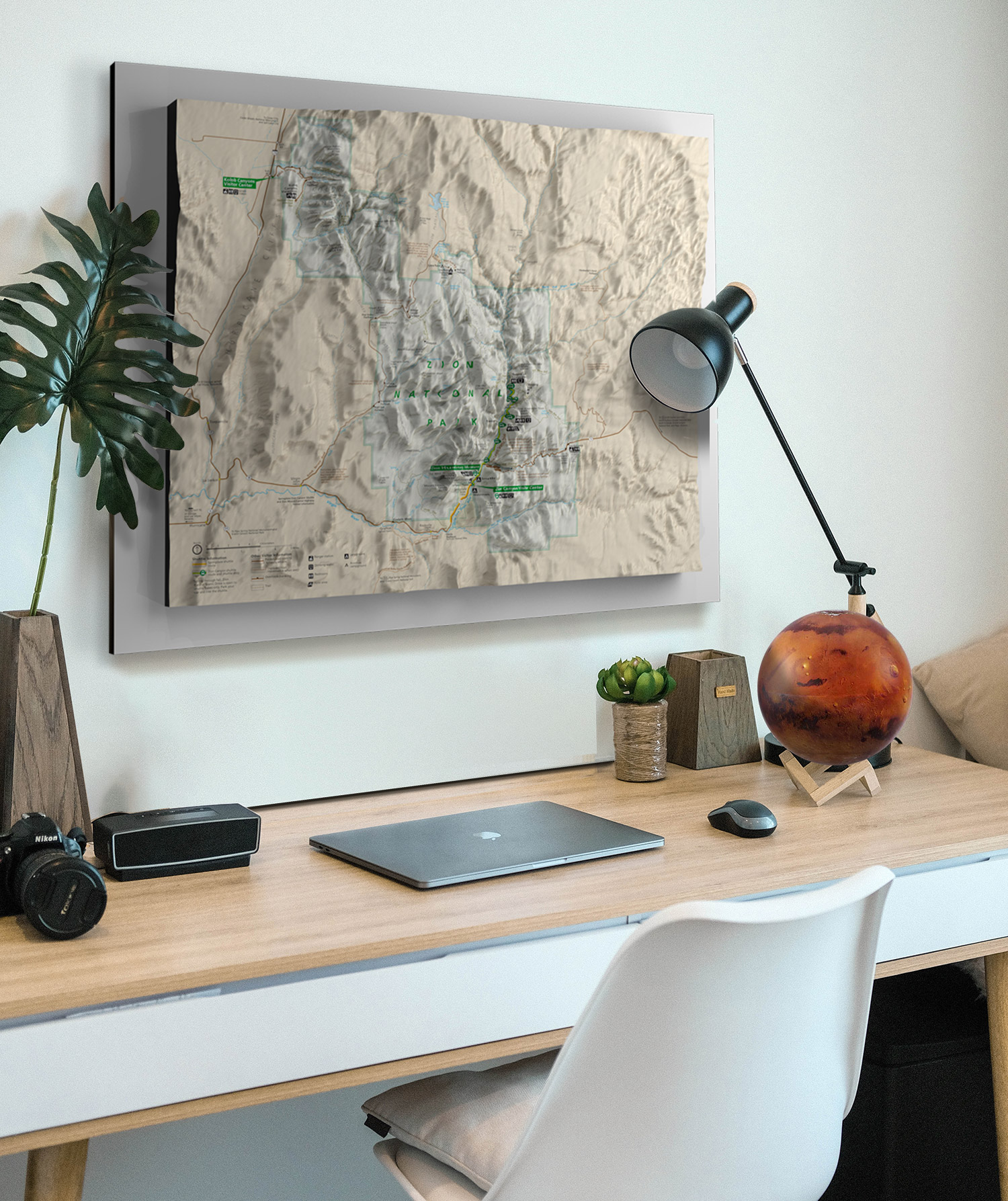 Zions National Park NPS 3D Map
Zions National Park NPS 3D Map
The Evolution of 3D Mapping: From Cartography to Cutting-Edge
The advancement of technology has ushered in a new era of exploration, one where our understanding of natural marvels like Zion National Park has taken a quantum leap. Traditional maps and photographs, while valuable, have given way to a game-changing innovation – 3D mapping technology. This revolutionary tool not only enhances navigation but also offers a deeper understanding of the intricate landscapes within Zion and beyond.
The Essence of 3D Mapping
At its core, 3D mapping technology is a fusion of science and artistry. It amalgamates satellite imagery, aerial photography, and meticulous ground-level data collection to craft highly detailed, three-dimensional renditions of the terrain. These physical models transcend the realm of mere paper maps or digital renderings, opening up new horizons for exploration and understanding.
Capturing the Lay of the Land
Traditional topographic maps, while invaluable, can often fall short in conveying the true essence of a landscape. In contrast, 3D maps breathe life into the geography they represent. Every crevice, contour, and crag of the terrain comes to life in these physical models. Imagine holding in your hands a tangible representation of the towering sandstone cliffs, the serpentine slot canyons, and the lush oases that define Zion National Park. These models provide an unparalleled tactile experience, allowing you to intimately connect with the landscape even before setting foot within the park’s boundaries.
Immersive Exploration
The beauty of 3D maps lies in their capacity to transcend two-dimensional limitations. They bridge the gap between the observer and the observed, transporting you into the heart of Zion’s geological wonders. With 3D maps, you can trace the contours of Angel’s Landing, feeling the elevation changes and precipitous drops as if you were there. You can virtually explore the sinuous paths of The Narrows, getting a palpable sense of the slot canyon’s depths and narrowness. This immersive quality is not only awe-inspiring but also invaluable for planning hikes, assessing the challenges ahead, and ensuring a safe and memorable adventure.
Understanding the Natural Forces
Moreover, 3D maps provide a unique opportunity to grasp the geological forces that have shaped Zion National Park. As you run your fingers over the models, you can visualize the eons of erosion that carved out these remarkable landscapes. The tactile nature of these maps allows for a deeper connection with the natural processes that created the towering sandstone monoliths, sculpted the narrow slot canyons, and nurtured the vibrant oases.
Conservation through Tangibility
Beyond their utility as exploration aids, physical 3D maps serve a vital role in conservation efforts. Park rangers and researchers use these models to understand and monitor the park’s changing landscapes. The tangible nature of these maps allows for hands-on training and the sharing of information among conservationists, ensuring that Zion National Park remains a pristine sanctuary for generations to come.
In essence, 3D mapping technology transcends the digital realm, offering a tangible and immersive way to connect with the geological masterpiece that is Zion National Park. These physical models serve as portals to a deeper understanding of the landscape’s intricacies and the forces that have shaped it, all while fostering a sense of wonder and stewardship for this natural treasure.
How 3D Maps Are Made: Unveiling the Magic Behind the Scenes
3D maps have revolutionized the way we navigate and explore the world around us, offering immersive and detailed representations of landscapes, cities, and natural wonders. But have you ever wondered how these intricate 3D maps are created? Let’s take a peek behind the curtain to uncover the magic of 3D map-making.
Data Acquisition: The Foundation of 3D Maps
At the core of any 3D map creation process is the acquisition of spatial data. This data forms the foundation upon which the 3D map is built. Several methods are commonly employed to gather this crucial information:
Aerial Imagery: Aerial photography and remote sensing techniques, including LiDAR (Light Detection and Ranging), capture high-resolution images and elevation data from airplanes or drones. LiDAR, in particular, provides detailed 3D point cloud data by measuring the distance between the sensor and the Earth’s surface.
Satellite Imagery: Satellite-based remote sensing technologies collect vast amounts of data covering large areas. This data includes color imagery, infrared imagery, and elevation data, allowing for a comprehensive view of the terrain.
Ground-Based Surveys: Surveyors use terrestrial LiDAR scanners, GPS technology, and other instruments to collect precise data from the ground. This data is often used to complement and refine aerial or satellite data.
Data Processing: Transforming Raw Data into 3D Models
Once the raw data is collected, it undergoes extensive processing to convert it into usable 3D models. This processing includes:
Data Alignment: Merging data from various sources and ensuring that it is accurately aligned in a common coordinate system is a crucial step. This alignment ensures that the 3D map accurately represents the real-world terrain.
Point Cloud Processing: For LiDAR data, point clouds are generated, where each point represents a specific location in 3D space. Filtering and classification algorithms are used to separate ground points from non-ground points (such as vegetation or buildings).
Mesh Generation: To create a more detailed 3D representation, the point cloud is converted into a mesh. This mesh consists of interconnected triangles that form the surface of the terrain.
Texture Mapping: Aerial and satellite images are draped onto the 3D mesh to provide color and texture, making the map visually appealing and realistic.
Visualization and Interaction: Making 3D Maps User-Friendly
Creating a 3D map is not just about data; it’s about making it accessible and user-friendly. Here’s how:
User Interface Design: Designing an intuitive user interface is crucial to allow users to interact with the 3D map effectively. This includes navigation controls, search functions, and overlay options.
Web-Based Platforms: Many 3D maps are accessible through web-based platforms or dedicated apps, making them available to a wide audience via computers, smartphones, and tablets.
Customization: Users often have the ability to customize their 3D map experience by choosing different layers, map styles, and viewing options to suit their needs and preferences.
3D maps are a fascinating blend of data collection, processing, visualization, technology integration and a more immersive connection with the geological marvels of Zion National Park. Whether you’re standing before a monumental sandstone monolith or preparing to traverse a narrow ridge, these maps serve as trusted companions, unveiling the intricate beauty of Zion’s terrain and facilitating unforgettable adventures within its hallowed landscapes. They provide us with powerful tools for navigation, exploration, and understanding of our world, and they continue to evolve, offering new possibilities for both practical and recreational applications.
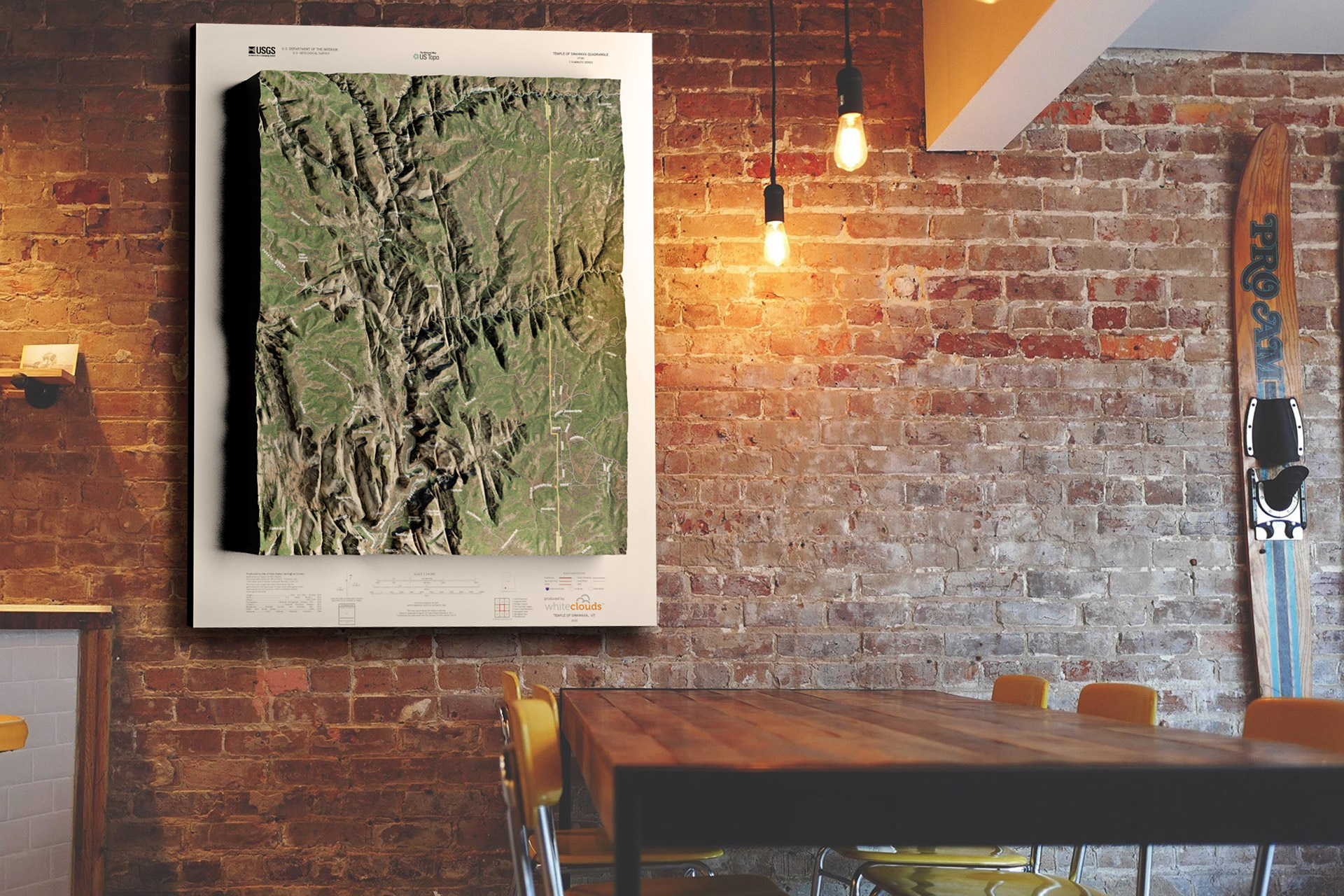 Zions National Park Satellite 3D Map – Temple of Sinawava
Zions National Park Satellite 3D Map – Temple of Sinawava
Journeying into the Subterranean World – Exploring Zion’s Slot Canyons in 3D
Within Zion National Park’s captivating tapestry of geological wonders, its network of slot canyons stands as one of the most mesmerizing chapters. These narrow, winding passages, sculpted by millennia of patient erosional forces, showcase Mother Nature’s artistry at its zenith. The integration of 3D mapping technology has now made it possible to unravel the secrets of these subterranean wonders in unprecedented detail and depth.
The Enigmatic World of Slot Canyons
Slot canyons are a geological anomaly characterized by their slender and sinuous nature. They often appear as if nature herself has chiseled narrow corridors through the heart of solid rock. Their walls, polished smooth by the relentless flow of water, reveal a kaleidoscope of hues, from deep crimson to the warmest ochre. Walking through these canyons is akin to wandering through a work of art, with each twist and turn unveiling a new masterpiece of nature.
Unlocking the Canyons in 3D
Thanks to high-resolution 3D maps, visitors can now embark on virtual expeditions into the depths of these iconic slot canyons. Imagine standing at the entrance of The Narrows, a hiker’s mecca. With a 3D map in hand, you can anticipate the mesmerizing twists and turns that lie ahead. These models offer a tantalizing glimpse into the labyrinthine passageways, allowing you to plan your journey meticulously, predict potential bottlenecks, and savor the anticipation of each hidden marvel that awaits.
An Essential Tool for Adventurers
For canyoneering enthusiasts, 3D mapping is a game-changer. The intricate details of the terrain come to life, offering invaluable insights into the technical challenges posed by each slot canyon. The elevation changes, the tight squeezes, and the potential obstacles all become tangible, enabling more informed route planning and a heightened sense of preparedness. These maps are not merely navigation aids; they become trusted companions for the intrepid souls who venture into Zion’s slot canyons.
The Photographer’s Paradise
Nature photographers, too, find an invaluable resource in 3D maps of slot canyons. These models allow for the anticipation and preparation of those perfect shots. Visualizing the interplay of light and shadow, understanding the angles and perspectives, and planning the optimal time of day for that iconic photograph becomes a precise endeavor. With the assistance of 3D mapping, capturing the otherworldly beauty of these slot canyons is elevated to an art form.
A Sense of Wonder and Exploration
Even for those not planning an immediate visit, 3D mapping offers a window into the heart of Zion’s geological treasures. It fosters a sense of wonder and exploration, inspiring individuals to embark on their own adventures and immerse themselves in the world of slot canyons when the opportunity arises. It’s an invitation to connect with the landscape on a deeper level and to appreciate the intricate beauty that lies hidden beneath the surface.
Unveiling the Park’s Hidden Treasures
Zion National Park is a tapestry of breathtaking landscapes, each with its own unique allure. With 3D mapping technology, visitors can uncover and explore intriguing areas that might otherwise remain hidden. Here are some of the fascinating locations you can discover using these innovative maps:
- Angel’s Landing: As one of the park’s most iconic hikes, Angel’s Landing stands out as a thrilling and challenging trek. The 3D maps vividly illustrate the steep ascent, the chain-assisted sections, and the awe-inspiring views from the summit. This vantage point allows you to plan your ascent meticulously and understand the terrain, which can be invaluable for those embarking on this exhilarating adventure.
- The Narrows: The Narrows is a captivating slot canyon adventure that draws visitors from all over the world. With 3D mapping, you can explore the twists and turns of the Virgin River, anticipate water levels, and get a sense of the towering walls that enclose this natural wonder. Understanding the terrain helps you prepare for this unique and often wet journey.
- Emerald Pools: Delicate waterfalls and emerald-colored pools nestle amid the rugged landscape of Zion. 3D maps showcase the hiking trails leading to these hidden gems, offering insights into the terrain and elevation changes. This allows you to plan your visit to these tranquil oases and appreciate their serenity even more.
- The Subway: This geological marvel is a challenging backcountry hike that leads to a tunnel-like formation resembling a subway tunnel. 3D mapping provides a virtual exploration of the entire route, from the challenging entry point to the mesmerizing subway itself. This feature assists intrepid hikers in preparing for the adventure and understanding the challenges involved.
- Observation Point: Offering an alternative perspective to Angel’s Landing, Observation Point rewards hikers with a breathtaking panoramic view of Zion Canyon. 3D maps give you an opportunity to virtually ascend this trail, showcasing the remarkable elevation gain and the grandeur of the landscape along the way. It’s a great tool for planning your visit and capturing the perfect viewpoint.
- Kolob Canyons: Located in the northwest corner of the park, Kolob Canyons is a hidden gem within a hidden gem. The 3D maps can guide you through this lesser-visited area, revealing the intricate canyons, picturesque viewpoints, and the scenic Taylor Creek Trail.
- Canyon Overlook Trail: Often considered a hidden gem itself, this short but spectacular hike offers one of the best views of Zion Canyon. 3D mapping technology helps you anticipate the trail’s twists, elevation changes, and offers insight into what awaits you at the trail’s end.
Conclusion
Zion National Park’s allure lies not only in its grandeur but also in the hidden treasures it harbors. With the aid of 3D mapping technology, these unique locations become more accessible and captivating, allowing visitors to plan their adventures with greater precision and appreciation. Whether you’re drawn to the challenging heights of Angel’s Landing or the serene beauty of Emerald Pools, these maps serve as a gateway to uncovering the park’s hidden wonders. Zion’s majesty awaits, now more accessible and mesmerizing than ever before, promising unforgettable experiences for all who venture within its red rock embrace.
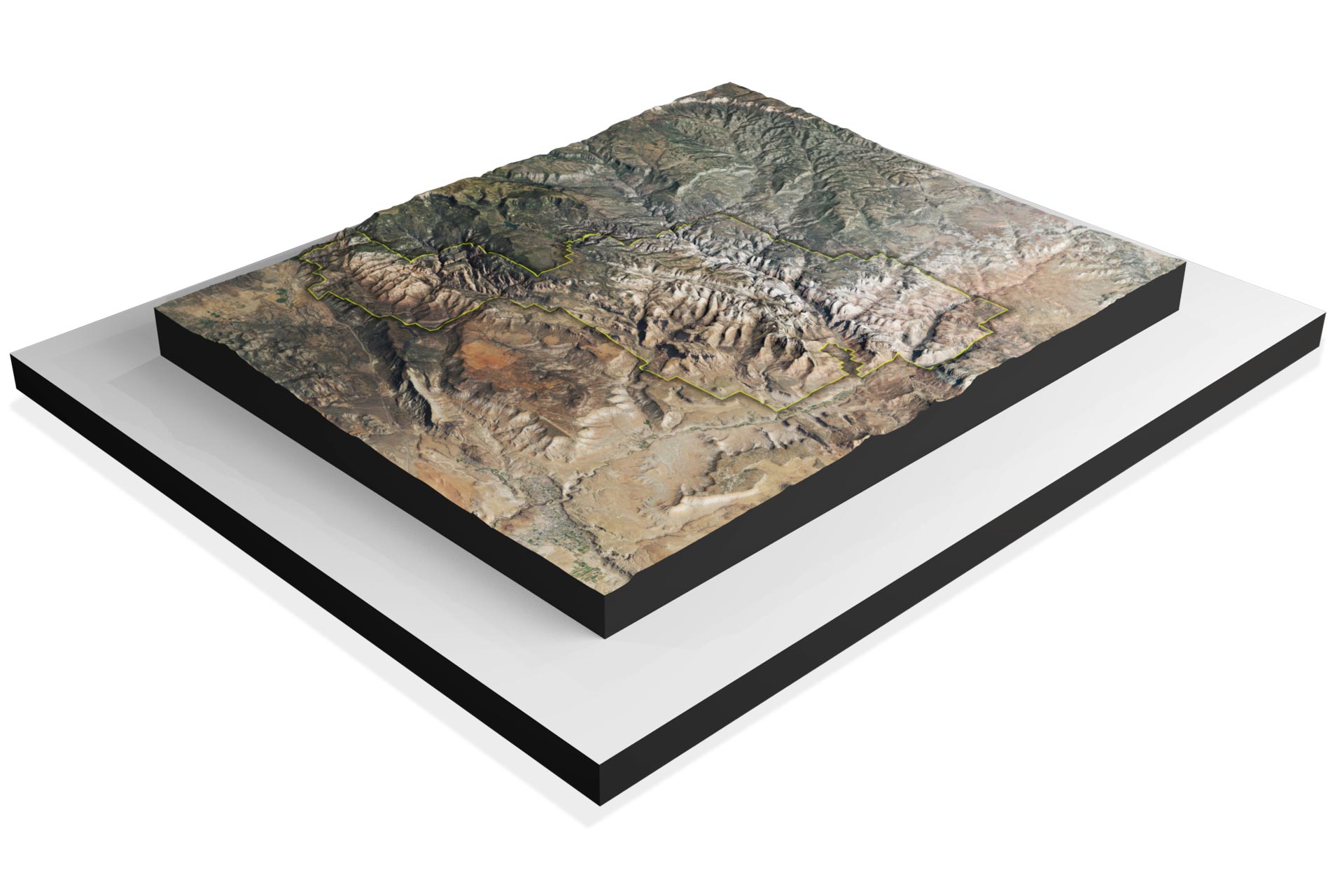
More National Park 3D Maps
To learn more in-depth about 3D National Parks Raised Relief Maps, view National Parks 3D Maps.
Arches National Park 3D Maps
Bryce Canyon National Park 3D Maps
Glacier National Park 3D Maps
Grand Canyon National Park 3D Maps
Grand Teton National Park 3D Maps
Rocky Mountain National Park 3D Maps
Smoky Mountains National Park 3D Maps
Yellowstone National Park 3D Maps
Yosemite National Park 3D Maps
Zions National Park 3D Maps
And once you’ve chosen your next destination, why not bring the beauty of the national parks into your home or office with our National Parks Canvas Wraps? Our canvas wraps feature stunning photographs of some of the most beautiful locations in the national parks, printed on high-quality canvas and stretched over a sturdy frame. They’re the perfect way to bring a little bit of the great outdoors into your home.
Contact us today to learn more about our services and how we can help you achieve your goals.
